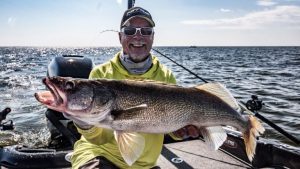 The idea that post-spawn fish scatter is only partly true. A better description is that they travel. At some point in April, nearly all of the fish were in rivers and sure enough, in another month most of the fish will be on deeper reefs or well-defined weed lines. Knowing key spots in between (and why the fish are there) can turn a mediocre day into a hot bite.
The idea that post-spawn fish scatter is only partly true. A better description is that they travel. At some point in April, nearly all of the fish were in rivers and sure enough, in another month most of the fish will be on deeper reefs or well-defined weed lines. Knowing key spots in between (and why the fish are there) can turn a mediocre day into a hot bite.
To understand the situation, think like a fish. Food levels in the river are not high enough, and larger fish must compete with the lingering smaller males for every morsel. So, after spawn larger fish ride the river currents back to the lake and they dive right in to the first food option they find.
In most cases, food is waiting at the river mouth. All rivers cut through some sort of delta or shallow flat where baitfish have gathered in spring looking for sun-warmed water due to the sand and mud. This can be as simple as a 6-foot river channel surrounded by a 3 to 4-foot deep flat. The larger the flat the better and anything deeper than 10 feet is probably not worth checking.
Shallow deltas of rivers like the Fox and Wolf flowing into Winnebago, and similarly, where the Fox enters Green Bay have the right characteristics. The Grand Bay of Lake Oahe has a similar situation and Brimley Bay near Sault St. Marie is a shallow area with at least a small amount of current.
Further south, some reservoirs only have creek inlets and others only have intermittent flow that reduce the overall pattern With the right flow, the warm flats fill up with multiple species including crappies, white bass, and catfish but the walleyes will be mixed in. As proof, the 2015 National Team Championship at Milford, Kansas was won trolling crankbaits on an inlet flat in May that many other anglers labeled, “catfish water.” (story was from Korey Sprengel)
While possible, picking out walleyes with Lowrance Structure Scan in this shallow water is just is not as efficient as throwing out a couple of lines and driving around for half an hour. We start these situations with a 5cm Berkley Flicker Shad Shallow 10 to 15 feet behind an Offshore Tackle OR-12 Planer Board near shore or parallel to any reeds, bulrush, or simply as shallow as you dare. For the rest of the boards, run a combination of Flicker Shads and Flicker Minnows on as many legal lines as possible to start combing the area at a relatively slow speed of 1.1 to 1.5 mph.
Standard trolling gear including 9-foot telescopic rods with line counter reels deftly handles a spread of planer boards. Fill each reel with exactly the same amount of 10-lb Berkley XT monofilament so that dive curves from the Berkley Flicker Shad package or the Precision Trolling Data phone app accurately place the lure near bottom. Do not worry if the flat varies a few feet in depth across its length; a crankbait in the lower half of the water column will drive strikes from these active fish.
We always expect scattered fish but unknown structure like a few rocks, a small depression or hump, can hold a surprisingly large group of walleyes. For this, we waypoint bites while trolling and keep jigging rods ready. When two or three boards go back at once in an area, you will be convinced to switch too.
To respond, we keep three or four Cabelas Prodigy 7’6” medium-light, extra fast action rods rigged with different-sized Bass Pro XPS jigs on the front deck. 2.5-inch Berkley Gulp! Minnows in many situations but Powerbait Jerk Shads and Powerbait Ripple Shads provide other options. The longer rod paired with 10-lb Berkley Nanofil or Berkley 8-Carrier braid makes long casts easy. Work the shallow area quickly until you contact fish. Later, a review with sonar will indicate if the fish were holding on something specific.
If we find some fish during the day, we might come back at night. Baitfish scatter in the sun, but huddle together for safety in low light. Obviously, this makes it easier for big walleyes to feed. Mark a safe trolling path during the day and stay for a few extra hours to see if trophy fish start feeding.
Flats fish are generally active so one pass often clues you in on fish densities. If not, another pass covering the 4 to 6-foot depth will be enough to know if the fish are there. This pattern generally lasts about two or three weeks depending on the stability of the water temperatures. If the area warms fast, the bait will eventually leave for safer water with more depth. If the winter holds a few more weeks, the bait will stick around.
When the bait leaves, the wind drives the next hot spot. Bait will end up at depths from 6 to 20 feet in areas affected by the prevailing wind. The tough part is the water temperatures are optimum for both the bait and the walleyes so multiple patterns set up at once and the spring winds change so the whole system moves.
This is what makes the shallow flats pattern golden. When it is on, the limited band of water temperature holds the fish hostage. As temperatures rise, it is much tougher to find the next bite.










